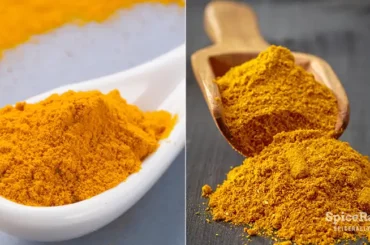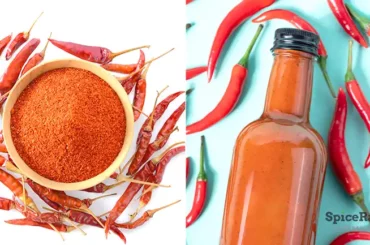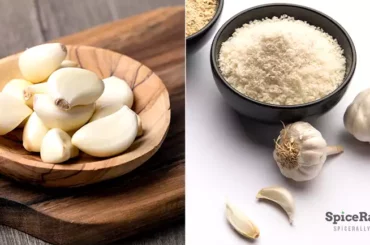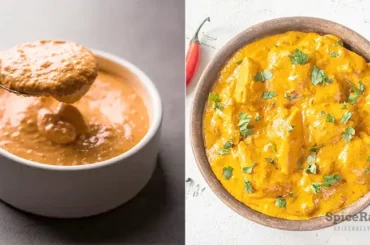Rasam and sambar are dishes that never leave a south Indian home! The spice blends used in them are so similar that they often tend to confuse us. Thus, let’s clear out everything about sambar powder vs rasam powder.
Rasam powder and sambar powder are so similar that we hardly see any difference between them. But in reality, rasam powder is different in proportions of the ingredients and its uses in cooking. In fact, sambar powder tends to be spicier and hotter while having a prominent pepperiness. And also, we won’t usually see the inclusion of coconut in rasam powder.
So, read along to learn more about the comparison between these two traditional Indian spice blends.
Sambar Powder vs Rasam Powder- SpiceRally DrillDown!
| Sambar Powder | Rasam Powder | |
|---|---|---|
| Base flavor | Warm and spicy | Warm and spicy |
| Main ingredients | Chana dal Toor dal Urad dal Red chiles Turmeric powder Coriander Cumin Black peppercorns Curry leaves Mustard seeds Fenugreek seeds It might also include the following: Salt (occasional) Coconut Asafoetida | Black peppercorns Cumin Coriander Red chiles Turmeric Curry leaves Fenugreek seeds Chana dal Toor dal Urad dal It might also contain the following: Garlic (occasional) Salt (occasional) Asafoetida |
| Flavor Profile | Has similar notes to rasam powder. But it can be hotter, spicier, and more flavorful than rasam powder with earthy and warm hints. | Possess similar taste elements to sambar powder. But contains a more peppery overtone, less heat, and spiciness compared to sambar powder. This also has warm, earthy, and savory flavor elements. |
| Heat and spiciness | Spicier and hotter than rasam powder | Relatively less spicy and hot than sambar powder |
| Texture | Somewhat coarse, dry powdery mixture | Somewhat coarse, dry powdery mixture |
| Color | Typically yellowish or brownish in color | Typically yellowish or brownish in color |
| Mode of usage in cooking | As an ingredient | As an ingredient |

| Usage in cooking | – Specifically used in making sambar curry – Spices up gravy and curry sauces – Can be incorporated into other vegetable and lentil curries – Flavors up rice dishes – Adds depth to liquid-based dishes like broths, soups, and stews | – Mainly used in making different types of rasam recipes. – Spices up rice dishes – Can be included in curry sauces and gravy – It can be used as an ingredient for rubs and marinades for meat and fish. – Can be added to egg dishes |
| Variations | Hardly vary: usually sticks to the same set of ingredients, | Many variations exist depending on the household and region |
| Origin | Indian cuisine | Indian cuisine |
| Availability | Can be purchased in different Indian brand names and is available in supermarkets, Asian grocery stores, and online vendors. | It can be purchased in different Indian brand names and is available in supermarkets, Asian grocery stores, and online vendors. |
| Mode of production | Commercial and domestically-made versions exist. | Commercial and domestically-made versions exist. |
| Storage | Most shop-bought sambar powder variants can be kept outside with the rest of your dry spices or seasoning in a tightly-fitting glass jar. But it is advisable to keep coconut-included homemade sambar powder in the refrigerator to have a longer shelf life. | Rasam powder can be stored in an air-tight glass spice container/jar, outside, with the rest of the dry spices, or in the refrigerator. |
| Culinary ingredient category | Spice mixture | Spice mixture |
More Insights Into The Difference Between Sambar Powder And Rasam Powder.
Straight from the shoulder, sambar powder and rasam powder are two of the most hardly-differentiative spice blends you’ll find in Indian cuisine. If you were given in the list of ingredients to make these two blends at home, you might wonder why you cannot make only one instead of two since the content is very similar.
But in reality, the amounts of these ingredients, along with a few elements used in each blend, vary. Sambar powder is richer in texture and sometimes even contains dried and toasted coconut, while we don’t usually see this addition in rasam powder. Moreover, sambar powder also contains more red chiles, mustard seeds, and coriander seeds.
On the other hand, rasam powder includes more black pepper than sambar powder. This makes sambar powder have a more pronounced coriander flavor along with more heat and spiciness. In the meantime, rasam powder tends to be more peppery but less hot and spicy than sambar powder.
And most importantly, sambar powder is primarily used to make the traditional Sambar Curry, while rasam powder is used to make different types of liquidy, soup-style dish Rasam. However, the recipe of sambar and rasam powders might slightly differ depending on the household and region in India.
Similar Reads…
Can Sambar Powder And Rasam Powder Be Used Interchangeably?
The short answer is a huge YES! Due to their similarity in ingredients, sambar powder can be an excellent substitute for rasam powder and vice versa. But you should remember that this is more effectively functional only to the recipes that call for each of these spice blends as a secondary element.
That is, using sambar powder in your rasam and rasam powder in your sambar curry will certainly not give the expected results. Therefore, if you are okay with the slight flavor differentiation that each blend could offer in place of each other, you are good to go with the relevant dishes.




